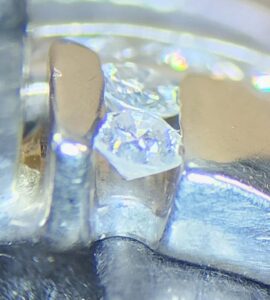Jewelry is more than just an accessory; it often holds sentimental value and requires care to keep it looking its best. Over time, the wear and tear of daily life can cause damage that may not be immediately noticeable. Regular inspections and repairs can help preserve your jewelry and prevent further damage. Here are some key indicators that your jewelry may need repair:














- You Hear Rattling When You Tap the Jewelry
One of the clearest signs that your jewelry needs attention is if you hear a rattling sound when you gently tap it or shake it. This could indicate that a stone is loose in its setting, whether it’s a diamond, gemstone, or even small accent stones. A loose stone can eventually fall out, leading to a costly replacement, so it’s essential to address this issue right away. If you hear any rattling, it’s time to visit your jeweler for a thorough inspection.
- Prong Wear (“Thinning”)
The prongs that hold gemstones in place are one of the most vulnerable parts of a jewelry piece. Over time, the tips of the prongs can wear down, a condition known as “thinning”. The more frequently you wear your jewelry, the more important it is to keep up with prong maintenance. Thin & worn prongs are a sign of weakness in the metal, and it easier for stones to become loose or even fall out as they become more worn. If you notice that the prongs look flat or thin, it’s a sign that the metal is wearing down. Getting the prongs retipped or replaced can help you avoid losing your gemstones or diamonds.
- Channel Wear (“Scalloping”)
Setting that feature a framework of metal to hold gemstones in place are among the most secure setting style. However, over time channels will begin to wear down from the top, the sides, or both, This visible condition if known as “scalloping” due to the rippled edge that begins to be visible around your gems as the metal wears away. Scalloping is a sign of weakening metal, making it easier for stones to become loose or even fall out. If you notice that your channels look ruffled, rippled, or scalloped; it’s a sign that the metal is wearing down. Getting the channels rebuilt before a gem or diamond falls out is the best way to save on maintenance in the future.
- Jewelry Snagging on Clothing or Fabrics (“Lifting”)
Have you noticed that your jewelry keeps snagging on your clothes, hair, or other fabrics? This is often a sign of “lifting,” where parts of the metal setting have become bent or are pulling away from the stone. Lifting can happen when the prongs or other components of the setting catch on something and get pulled out of place. Left untreated, this can lead to the stone becoming loose and eventually falling out.
- Regular Inspections Every Six Months
Even if your jewelry looks fine, regular maintenance is key to catching potential issues before they become serious. Experts recommend that you have your jewelry inspected at least every six months. A simple way to remember is to have your jewelry inspected when you change the clocks for daylight saving time. During an inspection, a jeweler will check the integrity of the setting, the condition of the metal, and the security of any gemstones, ensuring that your pieces remain in top shape.
- Gemstones Are Harder Than Metal
Most gemstones are harder than the metal used to set them, meaning that the stones can actually wear down the metal over time if they are loose. This can cause the setting to weaken and thin out, especially if the piece is worn daily. If you notice that the metal around your stones looks uneven, thin, or grooved, this is a sign that the stones are cutting into the metal. Repairing the setting can prevent further damage and preserve the life of your jewelry.
- Discoloration or Tarnishing
Another sign that your jewelry might need attention is discoloration or tarnishing of the metal. While tarnishing is common for silver and can be polished away, persistent discoloration could indicate more severe issues like plating wear or even metal corrosion. Gold and platinum can also wear down over time, so if your jewelry starts to look dull or discolored, it’s a good idea to have it inspected.
- Bent or Misshapen Bands and Shanks
If you notice that the band or shank of your ring or bracelet looks bent, warped, or misshapen, this is a clear indicator that your jewelry needs repair. A bent band can put change the pressure on the prongs holding your stones, leading to loose stones, prong damage, or even breakage of the metal. Catching this early and having the band reshaped or reinforced can help avoid more costly repairs later.
- Broken or Worn Clasps
The clasp is a vital part of necklaces and bracelets, and a broken or weakened clasp can result in losing the entire piece. If you notice that your clasp doesn’t close properly, feels loose, or shows signs of wear, it’s time for a repair. Worn-out clasps can be replaced or tightened to keep your jewelry secure.
- Scratches and Surface Wear
While minor scratches are normal, deep or excessive scratching can weaken the metal over time. Pay attention to the surface condition of your jewelry. If it looks overly scratched or has noticeable grooves, it’s worth having it checked. Polishing and refinishing can help restore its original luster and remove deeper scratches.
- Stones That Look Loose
https://youtube.com/shorts/tmjtQHec54M https://youtube.com/shorts/tmjtQHec54M
Scheduling biannual inspections with a professional jeweler will catch issues early and help maintain Jewelry is designed to last, but it requires regular care and maintenance. By keeping an eye out for these warning signs—rattling sounds, prong wear, channel scalloping, lifting prongs, metal wear from gemstones, and more—you can ensure your pieces remain in excellent condition. the beauty and integrity of your cherished jewelry.